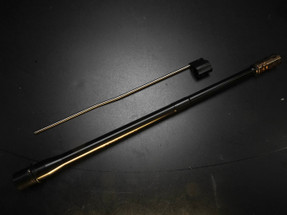Posted by WADE C. AND GPT on May 15th 2025
SELECTING THE CORRECT AR-15 BARREL! PART 5
SELECTING THE CORRECT BARREL — PART 5: BARREL TWIST RATES
Now that we’ve covered materials, length, gas systems, and contours, it’s time to dive into one of the most misunderstood yet important aspects of barrel selection: twist rate.
Twist rate refers to how quickly the rifling inside a barrel spins the bullet. It’s usually written as a ratio like 1:7, which means the bullet makes one full rotation every 7 inches. This spin stabilizes the bullet in flight and is crucial for accuracy and performance.
General Rules of Thumb
-
223/5.56 NATO: Most modern barrels are 1:7 or 1:8 twist. 1:7 handles heavier bullets better (69–77gr), while 1:8 is a versatile all-rounder.
-
6mm ARC: Commonly found in 1:7.5 or 1:7 twist. This supports the high-BC, heavy-for-caliber bullets that make the ARC perform so well.
-
22 ARC: Typically 1:7. Needed for the long-for-caliber, high BC projectiles that make this a standout varmint and long-range cartridge.
-
300 Blackout: Usually 1:8, but there’s growing support for faster twists—1:7 or even 1:5—especially to better stabilize subsonic bullets like 220gr SMKs or expanding subsonic rounds.
The Shift Toward Faster Twist Rates
As bullet designs evolve, especially with the rise of high-BC projectiles, manufacturers have begun adopting faster twist rates across the board. These faster twists help stabilize longer and heavier bullets for better precision—especially important for DMR, tactical, and long-range hunting applications.
There’s also a growing trend toward shorter barrels in modern AR builds. A shorter barrel often benefits from a slightly faster twist rate, to compensate for the reduced time the bullet spends engaging the rifling. For example, a 10.5” barrel with a 1:7 twist will stabilize a heavy bullet more reliably than the same twist in a 20” barrel.
Light Bullets and Fast Twists
If you’re running factory ammo, you typically won’t have to worry about twist rate mismatches. Most modern AR-15 cartridges are loaded with bullets that are appropriate for the barrel twist rates they’re most often paired with.
However, handloaders and experimenters should take note:
-
Running very lightweight bullets (like 35–45gr varmint loads) in a fast twist barrel (1:7) can be problematic.
-
The risk isn’t always accuracy—it’s overspinning the bullet.
-
When the bullet’s RPM exceeds ~300,000, you risk destabilization or even jacket failure.
RPM = (MV × 720) / Twist Rate
For example: A 35gr bullet leaving a 1:7 twist barrel at 3,300 fps would be spinning at over 340,000 RPM.
Too much spin can lead to:
-
Splashing: Where the bullet disintegrates on impact rather than penetrating.
-
Mid-air failure: Extremely rare, but possible with thin-jacketed or explosive bullets at high RPM.
That said, fast twist rates often improve group size even with light bullets, up to a point. Just be cautious if you’re running lightweight varmint projectiles in long barrels with maximum charges—especially when handloading.
The Reality of Twist Rates
The twist rate stamped on a barrel is a generalized specification. If you really want to know your barrel’s exact twist, measure it yourself:
-
Use a cleaning rod and a tight patch, then mark the rod at the start.
-
Rotate until the patch completes one full turn, and measure the distance the rod traveled.
-
That’s your true twist rate.
Most shooters will never need to do this, but precision builders and reloaders may benefit from confirming it.
Final Thoughts
In summary:
-
Twist rate is matched to the projectiles you intend to shoot.
-
Heavier = faster twist. Lighter = slower twist.
-
Modern AR barrels skew faster to accommodate today’s heavier, longer, more efficient bullets.
-
Know your use case. Know your ammo.
And if you’re handloading? Don’t forget to check your RPMs.

